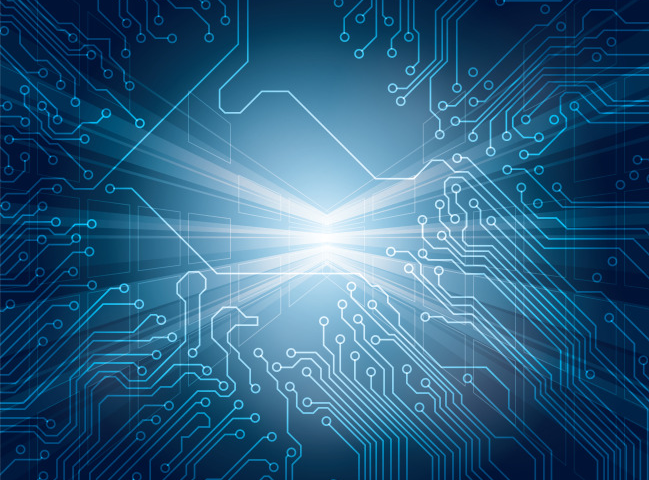PCB (printed circuit board) processing and production process
The raw material of PCB (printed circuit board) is glass fiber, which we can see in our daily life. For example, the core of fireproof cloth and fireproof felt is glass fiber. Glass fiber is easy to combine with resin. We have tight structure and strength. The high glass fiber cloth is immersed in the resin, and it hardens to obtain a heat-insulating, non-flexible PCB substrate-if the PCB board is broken, the edge is white and layered, which is enough to prove that the material is resin glass fiber.
It is impossible for us to transmit electrical signals with the insulating board alone, so we need to coat the surface with copper. So we call the PCB board a copper-clad substrate. In the factory, the code name of the common copper clad substrate is FR-4. This is generally the same among various board manufacturers, so we can think that everyone is on the same starting line. Of course, if it is a high-frequency board, it is best to use High-cost copper-clad PTFE glass cloth laminate.

The copper-clad process is very simple. Generally, it can be manufactured by rolling and electrolysis. The so-called rolling is to paste high-purity (>99.98%) copper on the PCB substrate by rolling-because epoxy resin and copper foil are excellent The adhesiveness of copper foil, the adhesion strength of copper foil and the high working temperature, can be dip-soldered in molten tin at 260°C without blistering. This process is quite like rolling a dumpling wrapper, the thinnest can be less than 1mil (industrial unit: mil, which is one thousandth of an inch, equivalent to 0.0254mm). If the dumpling skin is so thin, the filling will definitely leak out! The so-called electrolytic copper has already been learned in junior high school chemistry. CuSO4 electrolyte can continuously produce layers of "copper foil", which makes it easy to control the thickness. The longer the time, the thicker the copper foil! Usually the factory has very strict requirements on the thickness of copper foil, generally between 0.3 mil and 3 mil, and there is a dedicated copper foil thickness tester to test its quality. The copper coating on PCBs used by old radios and amateurs is very thick, which is far inferior to the quality in computer board factories.
Controlling the thinness of copper foil is mainly based on two reasons: one is that a uniform copper foil can have a very uniform temperature coefficient of resistance and a low dielectric constant, which can make the signal transmission loss smaller. This is different from the capacitance requirement. The dielectric constant is high, so that a higher capacity can be accommodated in a limited volume. Why is the resistance smaller than the capacitor? In the final analysis, the dielectric constant is high! Secondly, the temperature rise of thin copper foil is small under the condition of large current, which has great benefits for heat dissipation and component life. It is also the reason that the copper wire width in digital integrated circuits should be less than 0.3cm. The well-made PCB finished boards are very uniform and have a soft gloss (because the surface is brushed with solder resist). This can be seen with the naked eye, but there are not many people who can see the quality of the copper-clad substrate, unless you are in the factory. Experienced quality inspection.
For a PCB substrate covered with copper foil, how can we place components on it to achieve signal conduction between components instead of the entire board? The copper wire wound on the board is used to realize the transmission of electrical signals. Therefore, we only need to etch off the unused part of the copper foil and leave the copper wire part. How to achieve this step, first of all, we need to understand a concept, that is, "line film" or "line film", we print the circuit design of the board into a film with a photoetching machine, and then pair a main component A photosensitive dry film that is sensitive to a specific spectrum and undergoes a chemical reaction is covered on the substrate. There are two types of dry film, photopolymerization type and photodecomposition type. Water-insoluble and light-decomposable type are just the opposite.
Here we use a photopolymerization photosensitive dry film to cover the substrate first, and then cover a layer of circuit film to expose it. The exposed area is black and opaque, otherwise it is transparent (the circuit part). The light shines through the film onto the photosensitive dry film-what happened? Wherever the film is transparent and light, the color of the dry film becomes darker and begins to harden, tightly wrapping the copper foil on the surface of the substrate, just like printing the circuit diagram on the substrate, and then we go through the development step (using sodium carbonate solution to wash away Unhardened dry film) to expose the copper foil that does not require dry film protection. This is called a stripping process. Next, we will use the copper etching solution (chemicals that corrode copper) to etch the substrate. The copper without dry film protection is completely covered, and the circuit diagram under the hardened dry film is displayed on the substrate. This whole process is called "image transfer", which occupies a very important position in the PCB manufacturing process. Next is the production of multi-layer boards. According to the above steps, the production is only a single-sided board, even if the two sides are processed, it is only a double-sided board, but we can often find that the board in our hands is a four-layer board or a six-layer board (or even an 8-layer board).